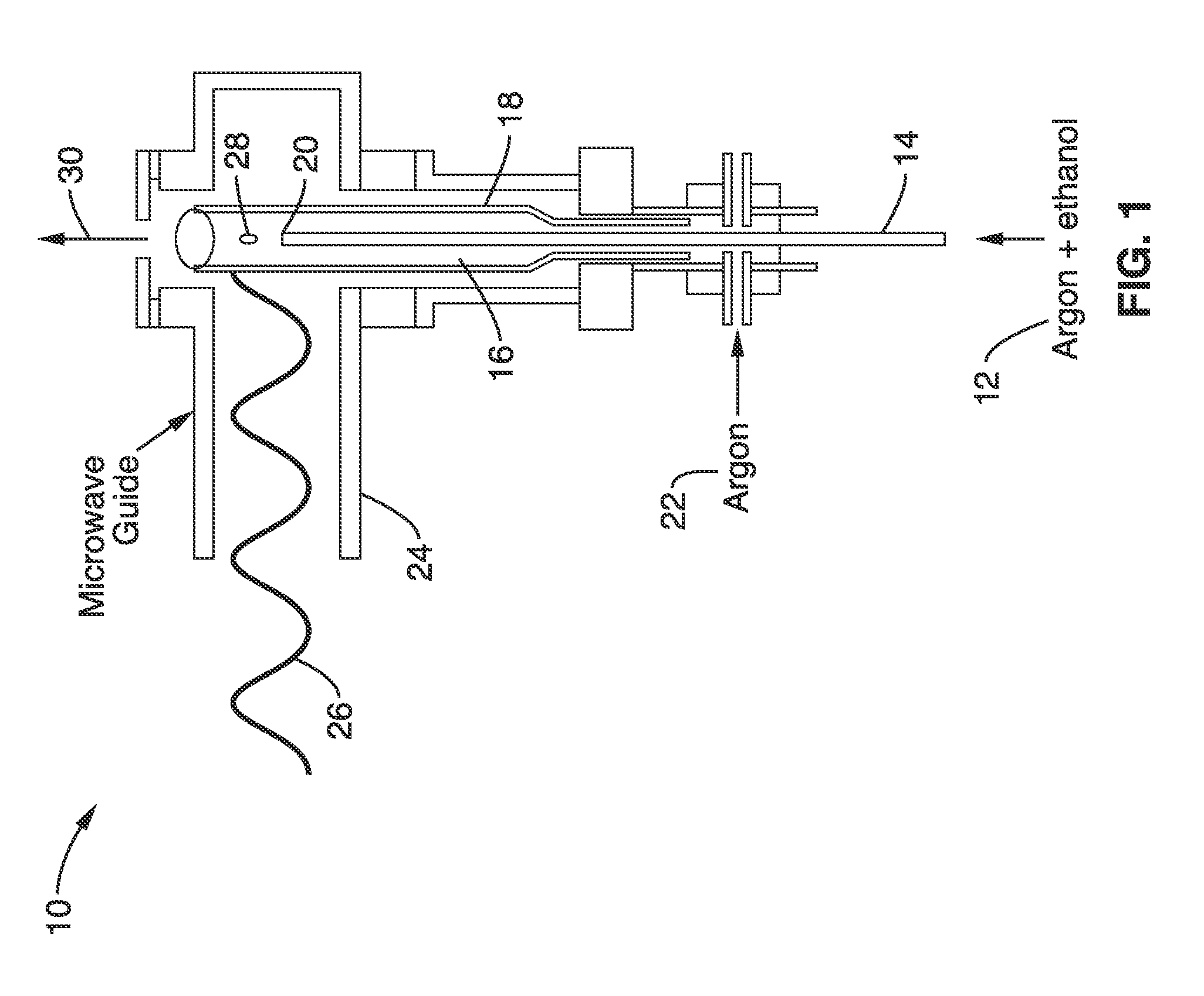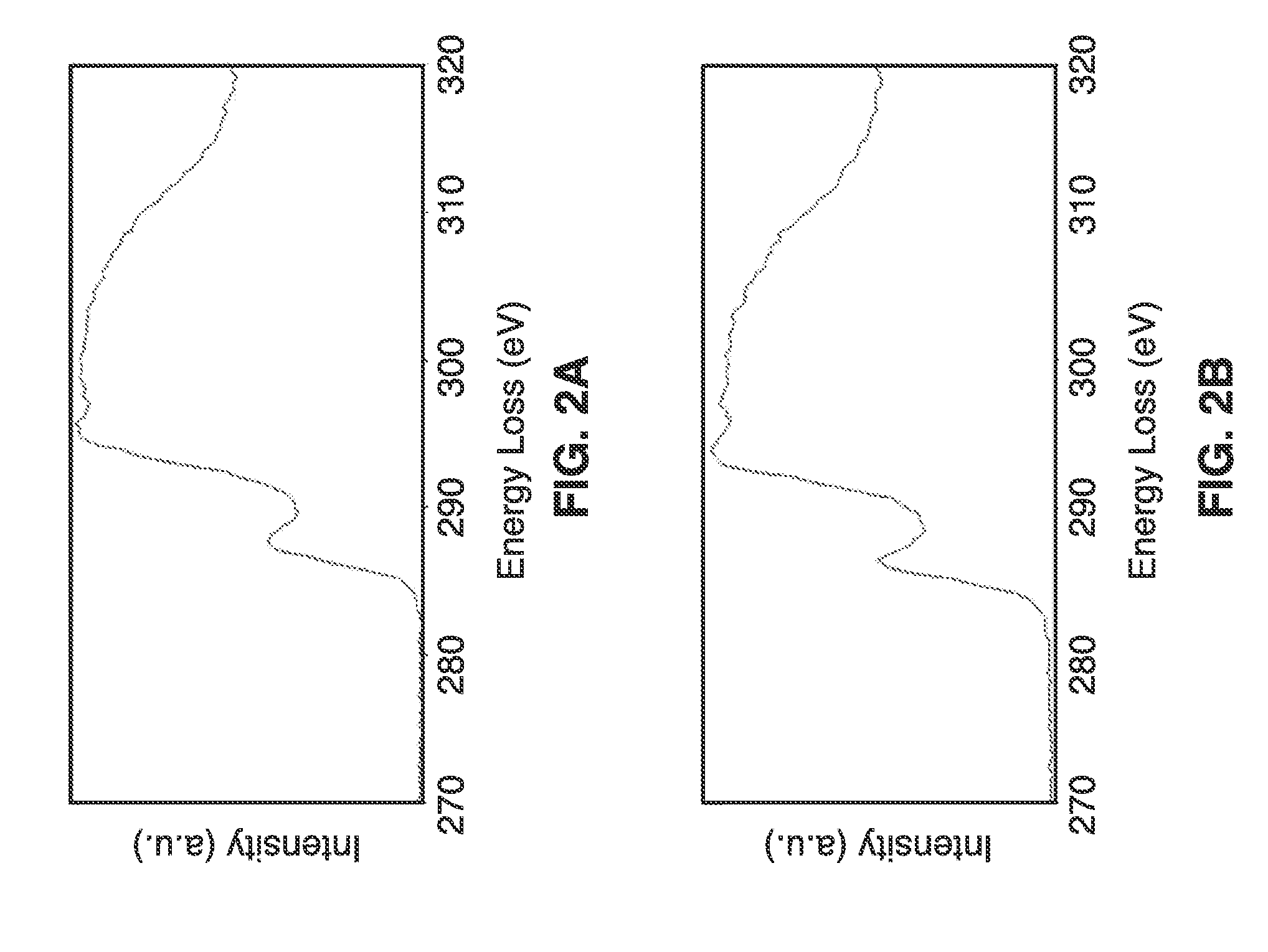Substrate-free gas-phase synthesis of graphene sheets
a graphene sheet, gas-phase synthesis technology, applied in material analysis using wave/particle radiation, instruments, nuclear engineering, etc., can solve the problems of direct imaging of surface molecules and interfaces between soft and hard materials on functionalized nanoparticles, and achieve uniform and easy production
- Summary
- Abstract
- Description
- Claims
- Application Information
AI Technical Summary
Benefits of technology
Problems solved by technology
Method used
Image
Examples
example 1
[0043]In order to demonstrate the functionality of the apparatus and methods, an atmospheric pressure microwave (2.45 GHz) plasma reactor as shown schematically in FIG. 1 was constructed. A quartz tube (21 mm internal diameter) located within the reactor was used to pass an argon gas stream (1.71 L / min) through a microwave guide. This stream was used to generate the argon plasma. A smaller alumina tube (3 mm internal diameter) located concentrically within the quartz tube was used to send an aerosol consisting of argon gas (2 L / min) and ethanol droplets (4×10−4 L / min) directly into the argon plasma. Ethanol droplets had a residence time on the order of approximately 0.001 seconds inside the plasma.
[0044]During the very brief period of time of plasma exposure, ethanol droplets rapidly evaporated and dissociated in the plasma, forming solid matter. After passing through the plasma, the reaction products underwent rapid cooling and were collected downstream on nylon membrane filters. T...
example 2
[0059]A second illustration of the functionality of gas phase synthesis apparatus and methods and the quality of the resulting highly ordered graphene sheets was provided using the apparatus shown schematically in FIG. 1. As described previously, an aerosol of liquid ethanol droplets and argon gas was introduced directly into an atmospheric-pressure microwave-generated argon plasma. Over a time scale on the order of 0.001 seconds, the ethanol droplets evaporated and dissociated in the plasma, forming solid matter of clean, highly ordered graphene.
[0060]The quality of the synthesized graphene sheets was determined using
[0061]Fourier transform infrared spectroscopy (FT-IR), X-ray photoelectron spectroscopy (XPS), elemental analysis by combustion, and an aberration-corrected transmission electron microscope (TEAM 0.5), which is capable of clearly resolving individual carbon atoms, defects, and adsorbates on graphene at an accelerating voltage of 80 kV. No post-synthesis treatments, suc...
example 3
[0070]Graphene has been proposed as an ideal TEM support because it is atomically thin, chemically inert, consists of light atoms, and possesses a highly ordered structure. Additionally, the material is electrically and thermally conductive, as well as structurally stable. As demonstrated here, the TEM imaging of molecular layers and interfaces between hard and soft materials can be achieved using graphene.
[0071]Graphene membranes were synthesized using the substrate-free gas-phase synthesis apparatus and method described above. The resulting graphene sheets were sonicated in ethanol to form a homogeneous suspension. Citrate-capped gold nanoparticles with a 10 nm average diameter were introduced into the suspension, which was then shaken by hand for 30 seconds to form a dispersion of nanoparticles and graphene. A drop of the suspension was deposited onto a Cu TEM grid with a lacey carbon support, which was air-dried prior to TEM characterization. A typical low-magnification image, o...
PUM
| Property | Measurement | Unit |
|---|---|---|
| plasma field | aaaaa | aaaaa |
| plasma field | aaaaa | aaaaa |
| internal diameter | aaaaa | aaaaa |
Abstract
Description
Claims
Application Information
 Login to View More
Login to View More - R&D
- Intellectual Property
- Life Sciences
- Materials
- Tech Scout
- Unparalleled Data Quality
- Higher Quality Content
- 60% Fewer Hallucinations
Browse by: Latest US Patents, China's latest patents, Technical Efficacy Thesaurus, Application Domain, Technology Topic, Popular Technical Reports.
© 2025 PatSnap. All rights reserved.Legal|Privacy policy|Modern Slavery Act Transparency Statement|Sitemap|About US| Contact US: help@patsnap.com



